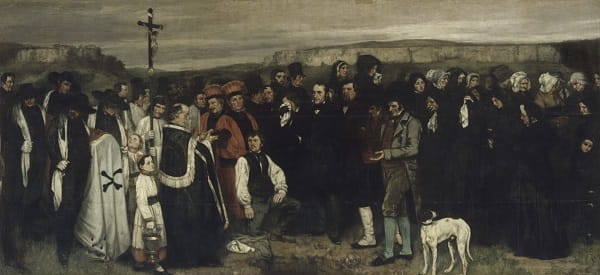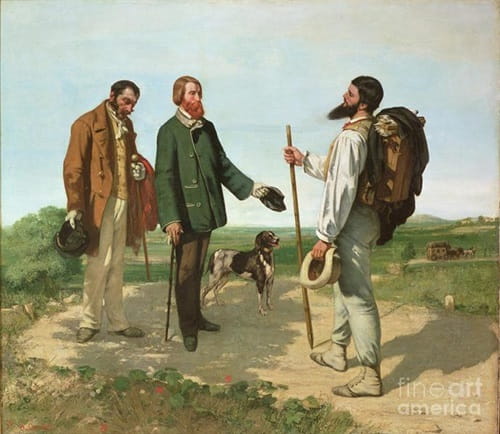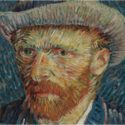Gustave Courbet ‘s Life and Art
Gustave Courbet, the trailblazing artist of the 19th century, was not merely a painter; he was a revolutionary force that shook the foundations of traditional art. Born in 1819 in Ornans, a picturesque town nestled in the heart of France, Gustave Courbet‘s early surroundings served as a wellspring of inspiration for his artistic pursuits. His upbringing amid the rolling hills and scenic landscapes instilled in him a profound appreciation for the raw beauty of nature, a theme that would later permeate his art.
Gustave Courbet‘s artistry was not confined to mere brushstrokes; it was a testament to his unwavering belief in authenticity. He believed in the power of truth, both in art and in life. His canvases became mirrors reflecting the diverse facets of society – from the toiling laborers to the solemnity of funerals, each stroke of his brush echoed the unembellished realities of the world.
As we embark on this exploration of Gustave Courbet’s life and art, we unravel the layers of a man who dared to challenge the status quo. His courage, creativity, and commitment to realism turned the art world on its head, inspiring generations to come.
Join us in this journey through the life and works of Gustave Courbet, where every painting tells a story, and every story echoes the spirit of a true artistic revolutionary.
Gustave Courbet: A Brief Overview
Early Life and Influences
Gustave Courbet’s early life was shaped by the picturesque landscapes and the vibrant cultural atmosphere of Ornans, a quaint town in the Franche-Comté region of France. Born on June 10, 1819, Courbet grew up surrounded by the rolling hills of the Jura Mountains, which would later find their way onto his canvases as a testament to his deep connection with nature.

Gustave Courbet (1819 – 1877).
From a young age, Courbet exhibited a keen interest in art, displaying an innate talent that was nurtured by his family’s encouragement. His parents, Regis and Sylvie Courbet recognized his artistic abilities early on and supported his passion for painting. His early exposure to the scenic beauty of Ornans instilled in him a profound appreciation for the natural world, which became a central theme in many of his later works.
In 1839, at the age of 20, Courbet moved to Paris to pursue formal art education at the Royal College of Fine Arts. During his time in the bustling capital, he was exposed to the rich cultural milieu of the city, encountering influential artists, writers, and thinkers of the time.
Paris, with its museums, galleries, and intellectual debates, provided Courbet with a stimulating environment that broadened his artistic horizons and fueled his creative ambitions.

The Village Maidens, 1851-1852 by Gustave Courbet.
It was in Paris that Courbet encountered the works of renowned painters such as Diego Velázquez, Francisco Goya, and Caravaggio, whose realistic and bold approach to art deeply resonated with him. These early influences, coupled with his observations of the social and political upheaval of the time, laid the foundation for Courbet’s revolutionary artistic style.
Courbet’s experiences in Paris and his exposure to diverse artistic traditions inspired him to challenge the prevailing academic conventions. He rejected the idealized forms of neoclassical art, choosing instead to depict the unvarnished realities of life. This inclination toward truth and authenticity would become the hallmark of his artistic career, setting him apart as a pioneer of the Realist movement.

Poachers in the Snow, 1867 by Gustave Courbet.
In the hushed ambiance of Ornans and the bustling streets of Paris, Gustave Courbet’s artistic vision took shape. His early life and influences not only shaped his technique but also fueled his determination to redefine the boundaries of art, leaving an indelible mark on the art world that would resonate for generations to come.
Gustave Courbet’s Artistic Style
Gustave Courbet, often hailed as the father of Realism, was a revolutionary artist whose unique style transformed the landscape of 19th-century art. His approach to painting was characterized by a profound commitment to truth, authenticity, and a rejection of idealized representations.
1- Realism and Truthful Representation
At the core of Courbet’s artistic philosophy was the belief in capturing the unfiltered reality of the world. He eschewed the romanticized and idealized portrayals prevalent in the academic art of his time.
Instead, Courbet chose to depict ordinary people, landscapes, and scenes from everyday life with an unmatched level of accuracy and precision. His paintings, such as “The Stone Breakers” and “A Burial at Ornans,” are poignant examples of his dedication to portraying the lives of common people in their truest form.

A Burial at Ornans, 1849-1850 by Gustave Courbet – Realism in Art.
2- Bold Brushwork and Texture
Courbet’s technique was characterized by bold and expressive brushstrokes. He was not concerned with creating a polished, smooth surface on his canvases; instead, he embraced texture and visible brushwork. This approach lent a sense of immediacy and vitality to his paintings, allowing viewers to feel the energy and emotion behind each stroke.
3- Emphasis on Light and Shadow
Courbet masterfully manipulated light and shadow to create depth and dimension in his paintings. His keen observation of natural light allowed him to infuse his scenes with a remarkable sense of realism. The interplay of light and shadow in his works added to the lifelike quality, making his subjects appear three-dimensional and tangible.

Poor Woman of the Village by Gustave Courbet – Gustave Courbet’s Paintings.
4- Portraits and Psychological Depth
In addition to his depictions of landscapes and everyday life, Courbet was renowned for his portraits. He had a unique ability to capture the psychological depth and individuality of his subjects. His portraits, such as “The Artist’s Studio” and “Jo, the Beautiful Irish Girl,” not only portrayed physical likeness but also revealed the inner thoughts and emotions of the people he painted.

Jo, the Beautiful Irishwoman, 1866 by Gustave Courbet – H. O. Havemeyer collection (1929) – Metropolitan Museum of Art.

The Artist’s Studio is a real allegory summing up seven years of my artistic and moral life between 1854 and 1855 by Gustave Courbet.
Recommended For You – Gustave Courbet’s The Artist’s Studio Analysis
5- Rejection of Traditional Hierarchy
Courbet challenged the traditional hierarchy of subject matter in art. While historical and mythological themes were considered superior in academic circles, Courbet elevated scenes from everyday life to the realm of high art.

The Homecoming, 1854 by Gustave Courbet.
Courbet’s insistence on depicting ordinary people and common activities was a radical departure from established norms, making a profound statement about the value of the everyday human experience.
Gustave Courbet’s Famous Paintings
1- The Desperate Man (Self-Portrait) (1845-1847)
“The Desperate Man” is a striking self-portrait that captures Courbet in a moment of intense emotional turmoil.
In this painting, Courbet portrays himself with a distressed expression, his eyes wide open and his hand gripping his hair in a gesture of desperation.

The Desperate Man, 1843-1845 by Gustave Courbet.
The painting is a powerful exploration of inner turmoil and existential angst, reflecting Courbet’s ability to convey profound emotions through his art. The intensity of the self-portrait makes it one of the most memorable and emotionally charged works in Courbet’s oeuvre.
Recommended For You – 10 Most Famous Self-Portraits of Art History
2- The Stone Breakers (1849)
“The Stone Breakers” is perhaps Courbet’s most famous painting. It depicts two rural laborers, a young boy and an old man, breaking rocks.

The Stone Breakers (Les Casseurs de pierres), 1849 by Gustave Courbet.
The painting is a powerful commentary on the harsh realities of rural life and the struggles faced by the working class. Unfortunately, this masterpiece was destroyed during an Allied bombing raid in Germany during World War II, but its significance in art history remains undiminished.
Recommended For You – Gustave Courbet’s The Stone Breakers Analysis
3- A Burial at Ornans (1849-1850)
“A Burial at Ornans” is a large-scale painting that portrays a funeral procession in Courbet’s hometown of Ornans.

A Burial at Ornans, 1849-1850 by Gustave Courbet.
The painting is notable for its realistic depiction of the mourners and the solemn atmosphere of the event. It challenged the traditional notion of what was considered suitable subject matter for high art, as it depicted an ordinary, everyday scene on a monumental scale.
4- The Artist’s Studio (1855)
“The Artist’s Studio” is a complex and multifaceted painting that is often regarded as Courbet’s manifesto of Realism.
In this work, Courbet portrays himself in the act of painting, surrounded by a diverse cast of characters representing different social classes, professions, and ideologies.

The Artist’s Studio, 1854 and 1855 by Gustave Courbet.
The painting is a statement of the artist’s role in society and a reflection of Courbet’s unconventional approach to art.
5- Young Ladies on the Banks of the Seine (1857)
This painting portrays two young women relaxing on the banks of the Seine River.

The Young Ladies on the Banks of the Seine, 1856-1857 by Gustave Courbet.
The composition captures a serene moment, highlighting Courbet’s ability to infuse everyday scenes with a sense of tranquility and naturalism.
6- The Meeting (Bonjour, Monsieur Courbet) (1854)
“The Meeting” is a self-portrait featuring Courbet meeting his patron and friend, Alfred Bruyas.

The Meeting (Bonjour, Monsieur Courbet), 1854 by Gustave Courbet.
The painting is notable for its composition, with Courbet depicted in the act of shaking hands with Bruyas. It reflects Courbet’s skill in capturing interpersonal dynamics and his ability to convey a sense of camaraderie.
7- The Wheat Sifters (1854)
In this painting, Courbet portrays two women sifting wheat.

The Wheat Sifters, 1854 by Gustave Courbet.
The meticulous attention to detail in depicting the textures of the wheat and the women’s clothing showcases Courbet’s mastery of realism.
The painting captures the dignity of labor, emphasizing the importance of everyday tasks.
8- The Trout (1872)
“The Trout” is a vibrant and dynamic composition that depicts a fisherman holding a freshly caught trout.
The painting is notable for its use of color and movement, capturing the energy of the moment.

The Trout, 1872 by Gustave Courbet.
Courbet’s ability to depict the play of light on water and the shimmering scales of the fish demonstrates his technical brilliance.
9- Jo, the Beautiful Irish Girl (1865)
“Jo, the Beautiful Irish Girl” is a captivating portrait of a young Irish woman named Joanna Hiffernan.

Jo, the Beautiful Irishwoman, 1866 by Gustave Courbet – H. O. Havemeyer collection (1929) – Metropolitan Museum of Art.
The painting is notable for its sensual and naturalistic portrayal of the subject, showcasing Courbet’s ability to capture the individuality and personality of his sitters. The painting’s boldness and intimacy are characteristic of Courbet’s style.
10- The Wave (1870)
“The Wave” is a dramatic seascape that showcases Courbet’s skill in capturing the power and force of nature.

The Wave, 1870 by Gustave Courbet.
The painting depicts a massive wave crashing against rocks, conveying a sense of awe-inspiring natural beauty and the sublime.
Courbet’s use of bold brushstrokes and contrasts between light and shadow creates a sense of movement and intensity.
Each of these famous paintings showcases Courbet’s extraordinary talent, his commitment to realism, and his ability to evoke deep emotions in the viewer. Together, they form a testament to Courbet’s enduring legacy as a pioneering artist of the Realist movement.
References:
- https://en.wikipedia.org/wiki/Gustave_Courbet
- https://www.wikiart.org/en/gustave-courbet
- https://www.wikiart.org/en/gustave-courbet/the-village-maidens-1852
- https://www.wikiart.org/en/gustave-courbet/poachers-in-the-snow-1867
- https://www.wikiart.org/en/gustave-courbet/a-burial-at-ornans-1850-1
- https://www.wikiart.org/en/gustave-courbet/poor-woman-of-the-village
- https://en.wikipedia.org/wiki/Jo,_the_Beautiful_Irishwoman
- https://artsandculture.google.com/asset/the-artist-s-studio-a-real-allegory-summing-up-seven-years-of-my-artistic-and-moral-life-between-1854-and-1855/iQF1RU4WTpm5uw?hl=en-GB
- https://www.wikiart.org/en/gustave-courbet/the-homecoming
- https://www.wikiart.org/en/gustave-courbet/the-desperate-man-self-portrait-1845
- https://www.gustave-courbet.com/the-young-ladies-on-the-banks-of-the-seine.jsp
- https://www.wikiart.org/en/gustave-courbet/the-meeting-bonjour-monsieur-courbet-1854
- https://www.wikiart.org/en/gustave-courbet/the-wheat-sifters-1855-1
- https://www.wikiart.org/en/gustave-courbet/the-trout-1872
- https://www.gustave-courbet.com/the-wave.jsp








